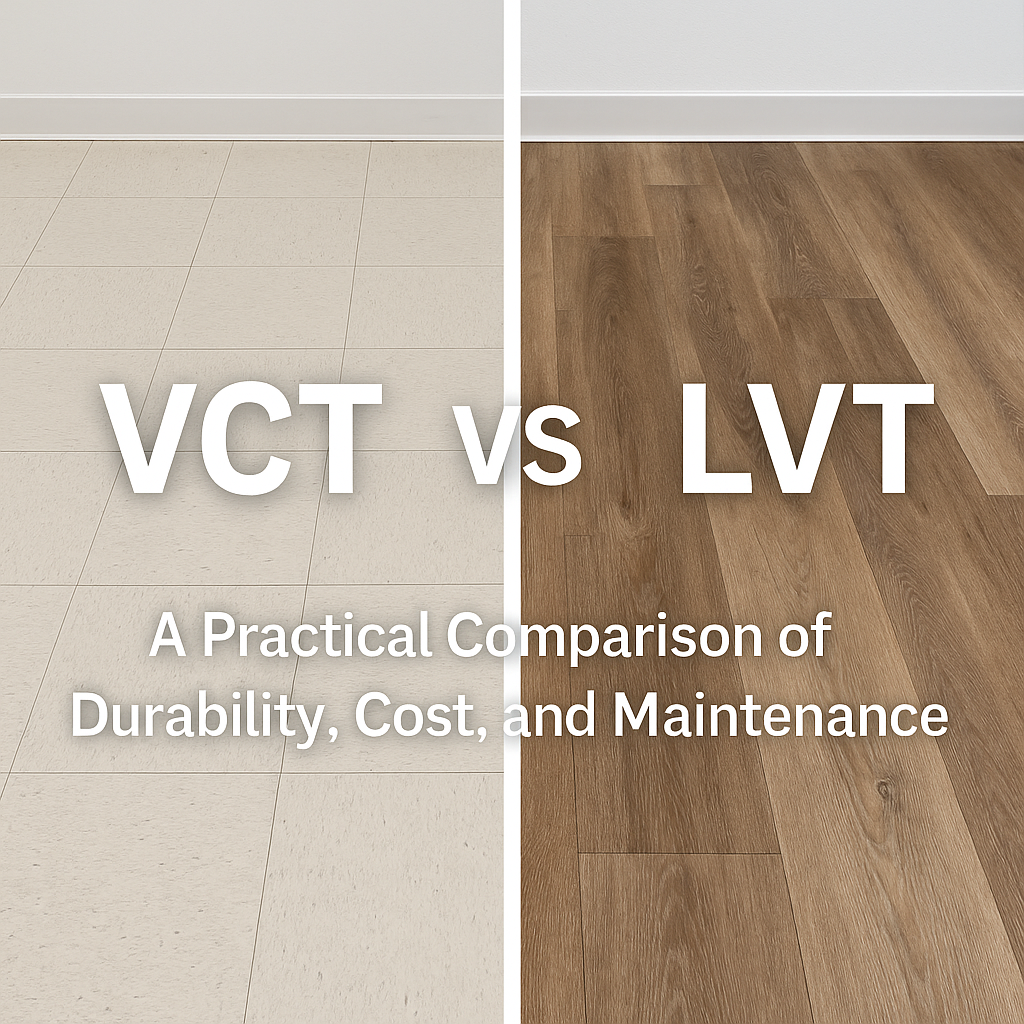VCT vs LVT Flooring: Cost & Durability Comparison
VCT TILE vs LVT: A Practical Comparison of Durability, Cost, and Maintenance
Durability: How VCT and LVT Perform in High-Traffic Texas Spaces
In busy Houston environments—think medical offices, schools, retail, and active family homes—floors see constant foot traffic, rolling loads, and Gulf Coast humidity.
- Scratches and dents: LVT (luxury vinyl tile/plank) typically includes a factory-applied urethane wear layer that resists scuffs, stains, and micro-scratches better than VCT. It stands up well to chair casters and carts when paired with proper floor protectors. VCT (vinyl composition tile) is dense and durable, but it relies on applied finish for surface protection; once that finish wears, scuffs and scratches show more readily.
- Moisture: LVT is more moisture-tolerant from the top down and doesn’t require wax to be serviceable, making it practical for Houston’s humidity and occasional spills. VCT is porous and depends on sealers/finish to resist moisture; neglected maintenance can allow staining or moisture intrusion. For either product, slab moisture from Houston’s many slab-on-grade buildings must be tested and managed before installation.
- Real-world performance: In a Houston clinic we recently evaluated, glue-down LVT with a 20-mil wear layer held up to rolling exam tables and disinfectant cleaning without the need for periodic waxing. By contrast, a school corridor with VCT performed well under heavy traffic but required routine burnishing to keep its gloss and resist black heel marks.
Cost Considerations: Upfront and Long-Term Investment

- Initial costs: VCT usually has a lower material price per square foot. However, it requires multi-step finishing after installation (sealer, multiple coats of finish), which adds labor. LVT costs more upfront, but installs without post-finish steps in most cases. Subfloor prep (smoothing compounds, leveling) is often similar for both and can be a significant line item in older Houston buildings.
- Long-term value: VCT’s ownership cost includes regular burnishing and periodic strip-and-wax cycles, plus chemicals, labor, and downtime. Those costs add up over the life of the floor. LVT typically needs only neutral cleaner and scheduled scrub-and-recoat with a maintenance finish if traffic is extreme. Over a 10–15 year horizon, many facilities find LVT’s lower maintenance and less downtime offset its higher material cost.
- Replacement cycles and hidden expenses: Both products can reach 10–20 years of service with proper care. LVT’s visuals and wear layers help it maintain appearance longer in many commercial settings. Hidden costs to consider include moving furniture for maintenance, closing areas during strip-and-wax, adding walk-off matting, and potential moisture mitigation if slab tests dictate. Plan for these early to avoid surprises.
Maintenance and Upkeep: What to Expect in Daily Use
- Cleaning routines: VCT needs a structured program—dust mop daily, auto-scrub with neutral cleaner, periodic burnishing, and scheduled strip-and-recoat to renew protection and gloss. LVT prefers a simpler regimen—dust mop, auto-scrub with neutral cleaner, and no finish required in most installations. In heavy-use Houston retail, a low-gloss maintenance coating on LVT can add scuff resistance without committing to full strip cycles.
- Ease of repair: Both are modular and can be repaired tile-by-tile or plank-by-plank. VCT is straightforward to heat and replace, though color matching older tiles can be tricky if lines are discontinued. Glue-down LVT repairs are also simple with the right adhesive and a sharp blade; matching pattern repeats and dye lots is the key. Click LVT is easier to replace at edges and trickier in the middle of a field.
- Appearance over time: VCT’s look depends on well-maintained finish; gloss can dull between burnishings. LVT’s factory urethane keeps a consistent matte or satin sheen and realistic wood/stone visuals that don’t require polishing. UV exposure from Houston sunlight can fade any flooring; choose products with UV inhibitors and use shades where appropriate.
Aesthetic and Design Flexibility for Texas Interiors
VCT delivers classic speckled and solid-color fields ideal for schools, labs, and back-of-house spaces. It can create cost-effective patterns, borders, and wayfinding with cuts and color blocks.
LVT offers a broader palette—convincing wood grains that complement Houston’s transitional and modern interiors, stone and terrazzo looks for lobbies, and oversized planks or tiles for visual scale in open-plan offices. Texture, beveled edges, and varied plank lengths add realism. For multifamily or single-family projects, LVT’s warmer underfoot feel and quieter acoustics are often preferred. In commercial spaces where branding matters, both products can integrate logos and color stories, but LVT typically wins on realism and perceived value.
Making the Right Choice: Next Steps for Houston Flooring Projects
Key takeaways:
- Need low maintenance and strong moisture tolerance? LVT is the practical choice for most Houston commercial and residential spaces, especially where downtime is costly.
- Working to a tight initial budget and okay with a wax/finish program? VCT can still be an excellent performer in schools, utility areas, and back-of-house corridors.
- For either option, proper slab testing, substrate prep, and the right adhesive under Houston’s humidity are non-negotiable for long-term success.
- Specify appropriate wear layers (commercial LVT commonly 20 mil or greater), use quality walk-off matting, and add furniture glides to protect your investment.
Every building is unique—age of the slab, HVAC cycles, occupant traffic, and cleaning resources all drive the best choice. If you’re planning a project in the Houston area, we can help you compare samples, confirm suitability for your space, and budget the true lifecycle cost.
Ready to move forward? Contact us to schedule a free quote or a slab moisture test. We’ll provide clear recommendations and a detailed plan to ensure your floor performs beautifully in Texas conditions.
